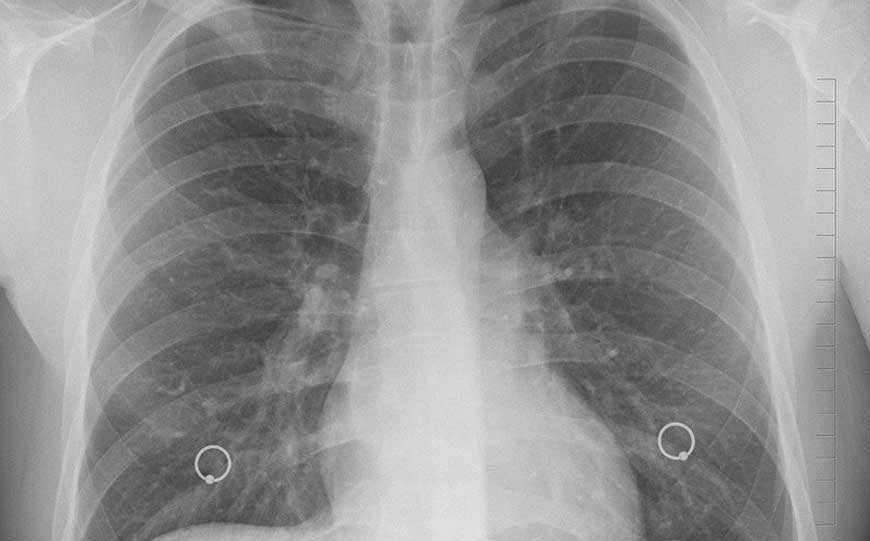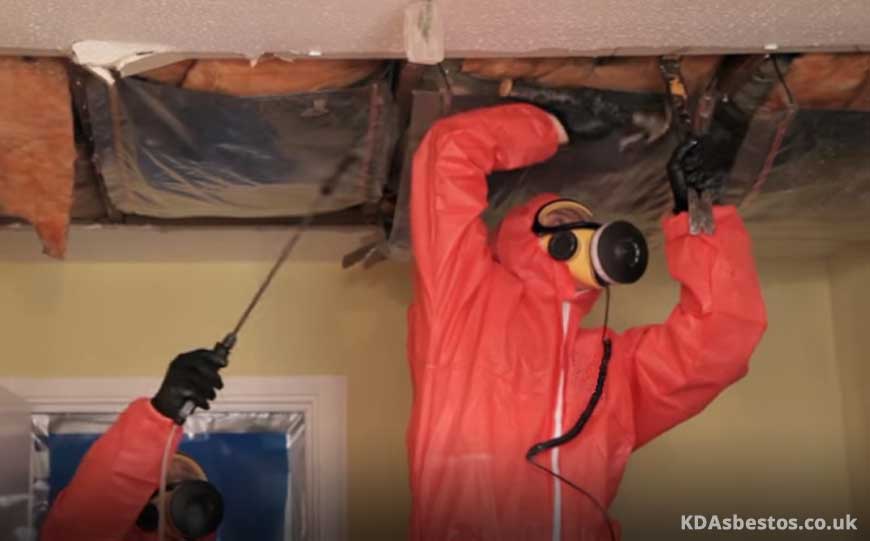
It is a known fact that prolonged exposure to asbestos is life threatening and can lead to extremely debilitating asbestos symptoms.
This fibre-like material was widely used in construction during the 1900s, and it can still be found in roofing, tiles, and insulation among many others.
While asbestos was banned in the UK back in 1999, sadly there were many construction workers who were exposed to it.
Moreover, if materials containing asbestos are damaged due to renovations or demolishing, the asbestos fibres can be released in the air.
When inhaled, the asbestos fibres will make their way in the lungs and remain there for several years.
Over time they will cause damage to the lungs.
This condition has in fact been named asbestosis, after the word asbestos.
However, many may not be well aware what the symptoms are and what the condition that can develop truly entails.
And this is just what we shall be discussing below.
Table of Contents
What is Asbestosis?

Image source: https://pixabay.com/photos/diagnosis-xray-chest-lungs-ribs-1476620/
Asbestosis is a chronic lung condition.
It is caused as a result of long term or prolonged exposure to asbestos fibres.
When asbestos fibres are inhaled, they make their way deep into the lungs.
These fibres will end up causing lung tissue scarring.
Often this results in a shortness of breath.
The symptoms of asbestosis vary.
They can be mild and they usually begin after several years since the exposure to asbestos occurred.
Over time symptoms generally become more severe.
Unfortunately most people who suffered from asbestosis acquired it due to their profession.
Several years ago asbestos use was neither regulated, nor prohibited.
Moreover, most workers who were being exposed to asbestos were not even aware of the dangers associated with the material, and many did not even wear appropriate safety gear to safeguard themselves.
Who’s at Risk?

As noted earlier, workers who used to work in the construction industry may have been exposed to asbestos fibres on a regular basis.
This does not only include construction workers, but also those who worked as:
- electricians
- plumbers
- heating and ventilation engineers
- miners
- boiler operators
- mechanics
- railroad workers
- shipyard workers
- refinery and mill workers
- demolition workers
The use of asbestos was prohibited by law in the year 1999 in the UK, and since then exposure to asbestos has been significantly reduced.
As a result, so has asbestosis.
However, it is important that should you be dealing with any renovation work or demolishing, you make sure that an asbestos test is carried out so that you will be alerted if the materials you might be dealing with contain any asbestos.
In such a way you will be able to take the necessary preventative measures and extra safety measures.
Common Asbestosis Symptoms

Image source: https://www.pexels.com/photo/young-man-in-sleepwear-suffering-from-headache-in-morning-3771115/
The effects of long term exposure to asbestos takes several years to show up.
Generally the symptoms start emerging between 10 to 40 years after the initial exposure to asbestos occurred.
During this period the asbestos fibres will have remained in the lungs and they will have been scarring the lungs.
Moreover the symptoms can vary considerably in their severity.
The most common symptoms of asbestosis include:
- Shortness of breath
- Dry cough which tends to be quite persistent
- Wheezing
- Crackling sounds when breathing
- Chest tightness or chest pain, sometimes also accompanied by pain in the shoulder
- Swelling in the neck or the face
- Difficulty when swallowing.
- Hypertension
- Blood in sputum
- The fingertips and the toes start appearing wider and rounder, often referred to as clubbing which generally occurs in more advanced cases of asbestosis
- Extreme fatigue
- Loss of appetite and weight loss
Most of these symptoms can also be associated with pleural mesothelioma, lung cancer and pneumonia.
Cause of Symptoms

The main cause of the symptoms mentioned above is the lung scarring that occurs as a result of the asbestos fibres in the lungs.
Over time the lungs will get inflamed, and they will be less capable of exchanging oxygen and carbon dioxide.
This in turn results in a reduction of the lung function, which makes the patient experience fatigue.
During the later stages of asbestosis, there will be even more stress imposed on the lungs as well as on the patient’s heart due to a lack of proper oxygen.
Consequently, many patients end up suffering from serious lung disease and/or heart failure.
The shortness of breath associated with asbestosis is also a very common symptom which results from the pleural thickening.
The long term exposure to asbestos fibres will lead to a thickening in the lining of the lungs.
It could also lead to pleural effusion, which is the buildup of fluid in between the chest wall and lungs.
This all results in impeding the proper functioning of the lungs and the heart.
More shortness of breath will result over time as more fluid will be building up.
Hence asbestosis can lead to a variety of symptoms, which will become more severe as years go by.
The disease basically prevents the lungs from fully oxygenating the blood, which in turn makes the heart work harder.
Blood pressure ends up increasing as a result of this, and more fluid builds up in the area around the heart and the lungs.
This in turn often leads to face and neck swelling, and difficulty swallowing.
In some cases there can also be fluid build up in the abdomen.
This leads to tenderness of bloating, that results in a loss of appetite, as well as weight loss.
If this fluid retention is not treated properly and in time, finger deformity, or clubbing, can result.
Treating Asbestosis

Image source: https://www.pexels.com/photo/blue-and-silver-stetoscope-40568/
If you are experiencing any of the above symptoms, and are unsure whether you may have been exposed to asbestos fibres in the past, make sure to consult with your GP.
The GP will check the lungs and generally refer you to a specialist in lung diseases for a number of specialised tests should asbestosis be a possibility.
These tests may include a chest x-ray, a CT scan of the lungs as well as lung function tests.
Sadly there is no cure for asbestosis once it develops since there is no way to reverse the damage that was caused to the lungs since the exposure to asbestos occurred.
As a result the treatment of asbestosis is generally focused on relieving the various symptoms the patient experiences.
One of the most important things is to stop smoking in case the patient smokes, as otherwise the asbestosis symptoms will get worse, and the risk for lung cancer increases exponentially.
Treatments offered generally include oxygen therapy and pulmonary rehabilitation.
The former involves breathing oxygen-rich air from a specialised machine or a tank to reduce breathlessness, particularly for patients who have very low blood oxygen levels.
Pulmonary rehabilitation on the other hand is composed of a programme whereby the patient is helped with carrying out certain exercises to manage the symptoms being experienced.
Generally an inhaler is also prescribed to ease the breathing.
Palliative treatment can help to reduce some of the symptoms associated with shortness of breath and coughing.
A thoracentesis or a pleurodesis may be advised for some patients.
In the more severe cases, doctors might recommend a lung transplant, however this is generally a last resort option.
Most patients suffering from asbestosis will not benefit from medication, unless there is another condition that also affects the lungs.
Small doses of morphine are sometimes administered to reduce breathlessness and coughing in the more severe cases.
Prognosis
Patients who have been diagnosed with asbestosis often end up developing lung cancer.
This is often the case if the patient has a history of smoking.
People with asbestosis are also at a higher risk of developing pleural disease, which is a thickening of the lungs’ lining, or pleura.
In some cases malignant mesothelioma can also occur.
Compensation
If you have been diagnosed with asbestosis, you might be able to claim compensation.
This can occur through a civil claim for compensation against a previous employer, or by means of a claim for governmental compensation under the Pneumoconiosis etc. (Workers’ Compensation) Act 1979.
You may also check whether you may be entitled to an industrial injuries disablement benefit.
Asbestosis Prevention

Even though asbestos is no longer permitted for use, it’s still important to be careful to prevent any exposure to it.
Materials found in older buildings can commonly contain asbestos and if damaged in some way, can lead to asbestos fibres becoming airborne and inhaled.
It’s also important to note that despite the fact that strict regulation with regards to the use of asbestos in the workplace was enacted back in the 1970 in the UK, the import and supply of brown and blue asbestos was not banned until the year 1985, whereas white asbestos was only banned as recently as 1999.
Hence there are many buildings which were built during that time, and there’s a good chance they may contain asbestos.
Therefore, if you are concerned that there could be asbestos in your house, make sure you seek the advice of a professional asbestos contractor, especially if you intend to renovate or demolish and have an asbestos survey carried out.
Even slightly damaged asbestos containing materials should be properly dealt with, such as by sealing, to prevent them from becoming friable.
Conclusion
It is important to be aware of the typical symptoms associated with asbestos exposure to seek medical assistance accordingly.
Considering that there is no cure for asbestosis, it is even more important to be extra careful to prevent exposure to asbestos containing materials.